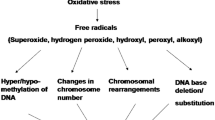Abstract
Interspecific hybridization is an effective method to generate a new crop in a short time that exhibits available traits. Nine interspecific hybrids between Allium fistulosum and A. macrostemon were produced through reciprocal crossings by ovary culture. This is the first report of hybrid development in the cross-combination. When A. macrostemon, a vegetative propagated plant, was used as the mother plant, no hybrid was obtained, but it was obtained by removal of bulbils and separation of the flower stalk, as with cut flowers. Ovary culture was performed on phytohormone-free B5 medium modified by Dunstan and Short (BDS) medium containing 30 g l−1 sucrose 7 days after pollination. Germinated embryos were transferred to BDS medium containing 1 mg l−1 6-benzylaminopurine and 15 g l−1 sucrose for 21 days. The plantlets were subcultured on phytohormone-free B5 medium for subsequent rooting. Hybridity was confirmed using cleaved amplified polymorphic sequence analysis of the rDNA internal transcribed spacer region and chromosome observation. In addition, the hybrids showed intermediate traits: they had fistulous leaves like those of A. fistulosum and bulbs like those of A. macrostemon. They displayed vigorous growth and propagated vegetatively by tillering. These results show the important discovery that vegetatively propagated plants are useful for cross breeding.




Similar content being viewed by others
Abbreviations
- 6BAP:
-
6-Benzylaminopurine
- BDS medium:
-
B5 medium modified by Dunstan and Short (1977)
- CAPS:
-
Cleaved amplified polymorphic sequences
- ITS:
-
Internal transcribed spacer
References
Amagai M, Ohashi K, Kimura S et al (1995) Breeding of interspecies hybrid between Allium fistulosum and A. tuberosum by embryo culture. Bull Tochigi Agr Exp Stn 43:87–94
Baldwin BG (1992) Phylogenetic utility of the internal transcribed spacers of nuclear ribosomal DNA in plants: an example from the Compositae. Mol Phylogenet Evol 1:3–16
Buiteveld J, Suo Y, van Lookeren Campagne MM et al (1998) Production and characterization of somatic hybrid plants between leek (Allium ampeloprasum L.) and onion (Allium cepa L.). Theor Appl Genet 96:765–775
Doležel J, Novák FJ, Lužný J (1980) Embryo development and in vitro culture of Allium cepa and its interspecific hybrids. Z Pflanzenzüchtg 85:177–184
Duke JA, Ayensu ES (1985) Medicinal plants of China. Reference Publications, Algonac
Dunstan DI, Short KC (1977) Improved growth of tissue cultures of the onion, Allium cepa. Physiol Plant 41:70–72
Fritsch RM, Friesen N (2002) Evolution, domestication and taxonomy. In: Rabinowitch HD, Currah L (eds) Allium crop science: recent advances. CABI Publishing, Wallingford, pp 5–30
Gonzalez LG, Ford-Lloyd BV (1987) Facilitation of wide-crossing through embryo rescue and pollen storage in interspecific hybridization of cultured Allium species. Plant Breed 98:318–322
Greenwood MS, Hopper CA, Hutchison KW (1989) Maturation in larch. I. Effect of age on shoot growth, foliar characteristics, and DNA methylation. Plant Physiol 90:406–412
Inden H, Asahira T (1990) Japanese bunching onion (Allium fistulosum L.). In: Brewster JL, Rabinowitch HD (eds) Onions and allied crops. Biochemistry, food science, and minor crops, vol 3. CRC Press, Boca Raton, pp 159–178
Hanelt P (2001) Alliaceae. In: Hanelt P (ed) Mansfeld’s Encyclopedia of agricultural and horticultural crops, vol 4, 3rd edn. Springer, Vienna, pp 2250–2269
Hashimoto S, Miyazawa M, Kameoka H (1984) Volatile flavor components of Allium grayi Regel. J Sci Food Agric 35:353–356
Kameoka H, Iida H, Hashimoto S et al (1984) Sulphides and furanones from steam volatile oils of Allium fistulosum and Allium chinense. Phytochemistry 23:155–158
Keller ERJ, Schubert L, Fuchs J (1996) Interspecific crosses of onion with distant Allium species and characterization of the presumed hybrids by means of flow cytometry, karyotype analysis and genomic in situ hybridization. Theor Appl Genet 92:417–424
Ogura H, Kondo K, Aizawa T et al (2000) Polyploidy distribution and karyotype variation in several wild populations of Allium grayi Regel (Liliceae) in Okayama prefecture, Japan. Cytologia 65:419–427
Ohsumi C, Kojima A, Hinata K et al (1993) Interspecific hybrids between Allium cepa and Allium sativum. Theor Appl Genet 85:969–975
Nomura Y, Makara K (1993) Production of interspecific hybrids between Rakkyo (Allium chinense) and some other Allium species by embryo rescue. Jpn J Breed 43:13–21
Nomura Y, Makara K (1996) Morphological and agronomical characteristics in interspecific hybrid plants between Rakkyo (Allium chinense) and other edible Allium species. Breed Sci 46:17–22
Nomura Y, Oosawa K (1990) Production of interspecific hybrids between Allium chinense and A. thunbergii by in ovulo embryo culture. Jpn J Breed 40:531–535
Pâques M, Boxus Ph (1987) “Vitrification”: review of literature. Acta Hortic 212:155–166
Peffley EB, Hou A (2000) Bulb-type onion introgressants possessing Allium fistulosum L. genes recovered from interspecific hybrid backcrosses between A. cepa L. and A. fistulosum L. Theor Appl Genet 100:528–534
Shimonaka M, Hosoki T, Tomita M et al (2002) Production of somatic hybrid plants between Japanese bunching onion (Allium fistulosum L.) and bulb onion (A. cepa L.) via electrofusion. J Jpn Soc Hortic Sci 71:623–631
Umehara M, Sueyoshi T, Shimomura K et al (2006) Interspecific hybrids between Allium fistulosum and Allium schoenoprasum reveal carotene-rich phenotype. Euphytica 148:295–301
White TJ, Bruns T, Lee S et al (1990) Amplification and direct sequencing of fungal ribosomal RNA genes for phylogenetics. In: Innes M, Gelfand D, Sninsky J et al (eds) A guide to methods and applications. Academic, San Diego, pp 315–322
Yanagino T, Sugawara E, Watanabe M et al (2003) Production and characterization of an interspecific hybrid between leek and garlic. Theor Appl Genet 107:1–5
Yurieva NA, Titova IV (1984) Embryo culture in vitro of interspecific hybrids of Allium L. genus. In: Noväk FJ, Havel L, Doležel J (eds) Proceedings of the international symposium of plant tissue and cell culture application to crop improvement. Olomouc, Czechoslovakia 24.-29.9.1984, Prague, pp 463–464
Author information
Authors and Affiliations
Corresponding author
Rights and permissions
About this article
Cite this article
Umehara, M., Sueyoshi, T., Shimomura, K. et al. Production of interspecific hybrids between Allium fistulosum L. and A. macrostemon Bunge through ovary culture. Plant Cell Tiss Organ Cult 87, 297–304 (2006). https://doi.org/10.1007/s11240-006-9167-2
Received:
Accepted:
Published:
Issue Date:
DOI: https://doi.org/10.1007/s11240-006-9167-2




